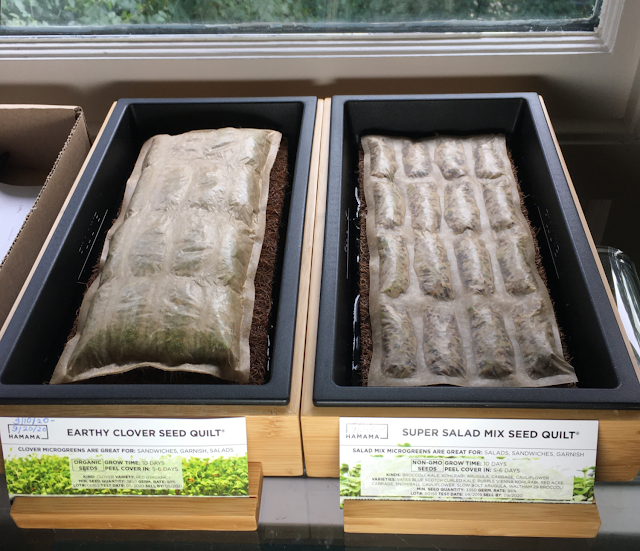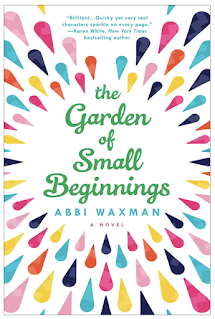I am impressed. They look good and are mainly red in colour and therefore easy for me to see in the garden. This is important as if I get distracted I can and do leave them anywhere, but red is a good colour for me to notice!
Wolf Bypass Secateurs

|
| With a Hamama Microgreens Starter Kit and the company's proprietary seed quilts, growing and harvesting fresh, delicious, and nutritious microgreens is nearly effortless! |
Fresh, crisp microgreens are colorful, refreshing, and extremely nutritious. Since last year, when I committed to making healthy lifestyle changes, including a special focus on healthy food choices, I have been adding microgreens to salads, sandwiches, soups, eggs, and other dishes as often as possible.
Although buying packaged microgreens at our local Whole Foods is an expensive and frustrating proposition, growing my own hadn't seemed like a viable option, given my poor track record with keeping even healthy plants alive, much less growing them from seed.
Then, four months ago, I found out about an innovative microgreens growing system from a company called Hamama, which was designed to be as as simple, effortless, and low-maintenance as possible, so that even container gardening newbies like me could grow these healthy, tasty, nutrient-dense greens year-round.
The proprietary, patent pending Hamama Seed Quilt Growing System is the brainchild of co-founders Camille Richman and Daniel Goodman, who met when they were mechanical engineering students at the world-renowned Massachusetts Institute of Technology. Following their graduation from MIT, they worked together full-time at the MIT Media Lab, researching high tech indoor agriculture. After growing food both in the lab and at home for several years, they wanted to make it possible for more people to experience the benefits of growing healthy food at home.
In May, I decided to order a Hamama Microgreens Starter Kit, including three seed quilts and a reusable grow tray. I was surprised and delighted by the results, and a few weeks later, I ordered two more growing trays and 18 more seed quilts. Although I've skipped a week here and there, I've successfully grown and harvested around more than a dozen seed quilts at this point. Now, I'm anxious to share my experience, and perhaps inspire others to try growing their own healthy, delicious, superfood microgreens, even if they have never had any experience, or luck, growing vegetables in the past.
P.S. Make sure to read all the way to the end of this review to find out how to get a 10% discount off the purchase price of your first order of a Hamama Microgreens Starter Kits, Seed Quilts, or other microgreens growing accessories!
Increasing our consumption of nutritious, dark leafy greens is an important part of healthy eating. The USDA Dietary Guidelines for Americans recommend eating more fruits and vegetables, including dark leafy greens. For those of us who have chosen a low carb, ketogenic approach to eating, dietary restrictions make it even harder to get enough nutrients from the foods we eat, rather than from supplements.
Adding more microgreens to our diets, in particular, provides even greater health benefits. A 2012 research study found that microgreens contain between four and 40 times higher concentrations of essential nutrients than their mature counterparts!
These nutrient-dense, immature plants can be excellent sources of key vitamins such as C, E, K, and also carotenoids including lutein and beta-carotene (a precursor to Vitamin A aka retinol), two important antioxidants provide a wide range of health benefits, including helping to protect our eyes against macular degeneration.

|
| We enjoy a large, colorful, salad with a generous helping of freshly harvested microgreens every day! |
Unfortunately, many supermarkets and grocery stores either don't sell them, or run out of them quickly. Even when I've been lucky enough to find one or two containers, those commercially grown microgreens have cost a pretty penny. Far too often, the expensive organic microgreens we've bought at our local Whole Foods Market have become not just limp but slimy and inedible after just one or two days in the vegetable drawer of our fridge. Most are also sold in single-use, plastic clamshell packaging, which is bad for the environment.
Finding organic microgreens or ones that have been grown from non-GMO seeds can also be a challenge.
Unfortunately, since March, these problems have been further exacerbated by the widespread negative impact of the current, unprecedented health crisis.
Buying packets of loose seeds and growing them on a bed of moistened potting mix, soil, or coconut coir is, without question, the cheapest way to grow microgreens at home. However, it also requires watering the seeds once or twice a day, and monitoring their progress daily, from the the time they are planted until they are ready to be harvested, usually takes somewhere between 9 days and a few weeks. And they do best with 4–6 hours of direct sunlight, or natural light supplemented by a grow light(s).
While this may be a good option for experienced container gardening enthusiasts, not everyone was blessed with a "green thumb," or enjoys growing things from seed. Some of us just want to have convenient and consistent access to a variety of microgreens and enjoy them when they are at their freshest, tastiest, and most nutritious, and are happy to pay more for an approach that requires significantly less time and effort than growing these immature greens from seed.
That's why Hamama developed its proprietary seed quilt system, which makes growing fresh, delicious, nutrient-rich microgreens indoors as easy, effortless, and care-free as possible.
Each seed quilt consists of three layers (excluding the seeds):
The seeds are sandwiched between the white felt layer and the light brown paper cover, divided into 20 long, narrow, rectangular, "quilted" sections that hold the seeds in place in a fairly even distribution.
Growing a Hamama microgreens seed quilt is as easy as 1-2-3:
You can harvest the entire seed quilt at once and store whatever microgreens you won't use immediately in the refrigerator, if you wish, or harvest a few sections at a time over the next few days.

|
| I often grow more than one Hamama seed quilt at a time |
Hearty Broccoli, Refreshing Cabbage, Spicy Daikon Radish, Super Salad Mix, Sweet Wheatgrass, Zesty Mix, Energizing Kale, Earthy Clover, Hot Wasabi Mustard, and Fragrant Fenugreek. All the seeds in Hamama's microgreens seed quilts are non-GMO Six are also organic (Energizing Kale, Fragrant Fenugreek, Hearty Broccoli, Spicy Daikon Radish, Earthy Clover, and Sweet Wheatgrass). The company is working on making the switch to an all certified organic line.
Use my Hamama shopping link, add the products you want to the shopping cart, then use the discount code SUPERGREENS during checkout to get 10% off your product total.
Hamama Microgreens Starter Kit and Seed Quilts Review by Margaret Schindel
My First Year on The Keto Diet
Preparing to Succeed on the Keto Diet, Part One
Preparing to Succeed on the Keto Diet, Part Two
Low Carb Muffins & Cupcakes: Treats to Enjoy on a Keto Diet
Low Carb Keto Chocolate Yogurt Granola Chip Pudding Recipe
Good Dee’s Keto Cookie Low Carb Baking Mix Review
Hamama Microgreens Growing Kit Review & Success Tips
My Favorite Hamama Microgreens Seed Quilt Accessories
Keto Cheddar Cheese Biscuits With Chives Recipe
The Ultimate Keto Hot Chocolate Recipe
The Best Low Carb Keto Gift Ideas: Keto Gift Guide
The Best Low Carb Keto Cinnamon Muffins
Wholesome Yum Keto Bread Mix and Yeast Bread Recipe
The Good Chocolate 100% Organic No Sugar Dark Chocolate Review
The Best Advice to Maintain Your Keto Diet Weight Loss
My New Irresistibly Delicious Keto Cheese Crackers Recipe
Luscious Low Carb Keto Triple Peppermint Cheesecake Brownies Recipe
Quick & Easy Livlo Blueberry Scones Keto Baking Mix Review
Snack Better With The Best Healthy Keto Cookie Dough Bites
The Best Quick and Easy Low Carb Keto Pizza Recipe
The Best Quick and Easy Low Carb Keto Shortcake Cupcakes Recipe
Comparing the Best Keto-Friendly Chocolate Hazelnut Spreads - No Added Sugars
The Best Low Carb Keto Sandwich and Burger Buns Mix
Blueberry Biscuit Scones — New, Easy, Low Carb Keto Recipe
The Best Keto Pizza Crust Mix With 0 Net Carbs
An Unusual, Delicious Strawberry Chocolate Tea With 0 Calories
Delicious Sugar-Free Keto Cookies That OREO Fans Will Love
Healthy Pistachio Cherry Chocolate Chip Marshmallow Cereal Treats Recipe
Easy, Decadent, High Protein, Sugar-Free Rocky Road Cottage Cheese Ice Cream
The Best Quick & Easy Low Carb Sausage and Ricotta Calzones
How to Make Refreshing Vanilla Italian Soda (With or Without Cream)
How I Stayed Committed to the Ketogenic Way of Eating
Plants that need to be brought indoors need special care- A Garden Review
I know I am scoping out all the window areas of my apartment for possible "growing spots", for all the plants I took out to my balcony in the spring.
One of the most important parts of bringing our favorites back to the indoors, is making sure there are no hidden "bugs" hitchhiking their way indoors.
During the summer months outdoors your plants have been visited by many flying, crawling and maybe even jumping insects. Believe it or not I had a grasshopper on one of my plants and we are on the 18th floor of our building. So anything is possible.
When I am bringing my plants indoors, I like to un-pot them! Yes you heard me right. I take my plants out of their pots, set aside the soil they were growing in and move the plants into by bathroom.
Then I shower them well with warm water, on both the top sides of the leaves and the bottom sides as well. I check their roots and if there are roots that look decayed I will snip them back.
I also check their stems to see if there are any scale insects that may have made their home on my plants. One of my Ivies is infested with scale, so I will take cuttings from it and treat the cuttings with Safer's Soap spray. Then I will root these cuttings and start with fresh soil in a few weeks. They will be potted up only when I am sure they are free of the scale insects and have set new roots.
I do get the pots and clean them out with a good hot soapy water solution, and then let them air dry. I will use fresh soil in these pots to give the plants and cuttings a good start in their indoor home.
With my plants, especially the orchids, I let them stay outdoors until the temperatures drop to about 10 degrees Celsiusor 50 degrees Farenheit. Most orchids like a real drop in temperature for a few nights as it signals the plant to set flower bearing stems. Do NOT let these delicate plants freeze! If there is a chance of the temperatures going down close to freezing, bring them indoors for the night.
By January you should be seeing lots of stems on your orchids that will surely lead to some gorgeous flowers. One of my orchids starts blooming in January and doesn't stop till June or July. They are truly one of my many joys.
Having said that, orchids do need special care. Their leaves are tightly figured and can harbor scale or other bugs. I make sure they are drenched with Safer's Soap Spray before they come in for the winter! You can spray them once a week on both sides of their leaves. Better to be safe than sorry. If one plant comes in with a scale infestation, it can ruin all your plants in very short order.
Bringing our plants indoors is a time consuming endeavor if you are a crazy gardener like me. If you only have a few plants(3 or 4) outdoors, you should be able to do this in a weekend. If you are more like me, and have 8-10 plants to bring indoors, you might need a couple of weekends to finish the task.
You don't need to be in a hurry yet, but don't leave this task till late October or November. Then you will be scrambling to get it done. Bringing in the plants without checking them well for pests, could be your downfall. Take the time while the weather is still relatively nice and do it now. Check them all closely and if you don't want to start with fresh pots and soil, you can also drench the plants and soil with the Safer's Soap. It is better to do that then to just bring them indoors without any preventative measures at all.
I am excited to have been able to order a packet of Watermelon seeds from Baker Creek Heirloom Seeds. I am very excited about this coming gardening season. This Watermelon variety is the "Strawberry". It is the most delicious watermelon I've ever tasted.
However, with the current craziness of 2020, including difficulty with the supply chain, I thought I'd buy my garden seeds now. In order to ensure I have seeds when it is time to start them. This watermelon is one of the plants I am most excited to try to grow.
I had been hearing, from serious gardeners, that they were extremely pleased about their Strawberry Watermelons. They were happy about the plants, the size of the melons, and the wonderful taste. At that same time, I had the opportunity to taste some of this melon. It was delicious! So flavorful. I love watermelon and eat some about 5 days a week during season. Some from the grocery and some from local farms. But none were as flavorful as the Strawberry Watermelons. There is a bit of a berry flavor - slightly different than a typical watermelon. But it is not overpowering. And the traditional melon flavor is present.
More about this variety:
They carry familiar plants and varieties as well as plants and varieties you have likely never heard of. I have placed two orders and have received both orders without problems and in a timely fashion.
The headquarters is a place that during normal times (as opposed to during times of quarantines and social distancing) can be visited. Watch for announcements for the re-opening of their village, store, and restaurant near Mansfield, MO.
In the meantime, you can browse their selections online or request a printed catalog.
In addition to their vegetable seeds, they offer some gorgeous flowers. I always try to plant some flowers for the pollinators. This year I can't wait to plant these gorgeous Zinnia's along with several varieties of sunflowers.
I have never seen these types of Zinnias, have you? I love "regular" zinnias. I can only imagine how amazing these will be in my "garden".
 Hi, my writing name is Raintree Annie and I am otherwise known as Jasmine Ann Marie. In life and online I get called any combination of those names! I am really happy to be a part of the Review This Reviews
writing group. I started writing many years ago and always love it most when I am part of a creative and enthusiastic writing family.
Hi, my writing name is Raintree Annie and I am otherwise known as Jasmine Ann Marie. In life and online I get called any combination of those names! I am really happy to be a part of the Review This Reviews
writing group. I started writing many years ago and always love it most when I am part of a creative and enthusiastic writing family.  |
| Check Here for Lowest Price |
“As an Amazon Associate, Ebay (EPN) and or Etsy (Awin) Affiliate, I (we) earn from purchases.” Disclosure Statement